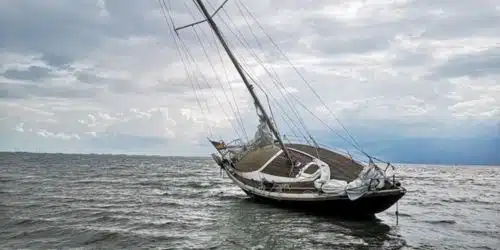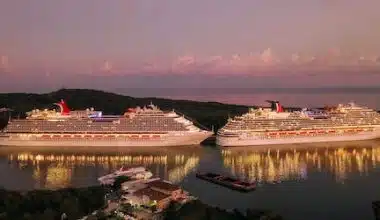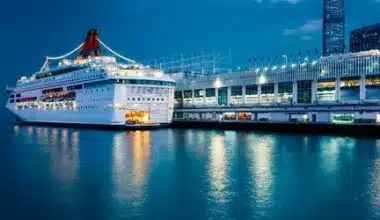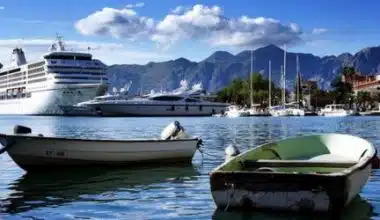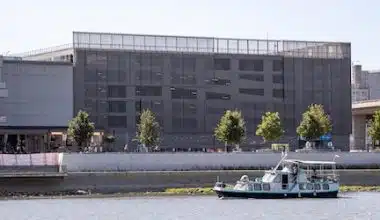Cruise ship deaths are a rare occurrence, but they do happen. In fact, according to the Cruise Lines International Association (CLIA), there were an average of 200 cruise ship deaths per year between 2000 and 2019.
While accidents, suicides, and homicides account for a small proportion of cruise ship deaths, the majority are due to natural causes like heart attacks and strokes.
In this blog post, we will discuss the leading causes of cruise ship deaths and how to prevent them. We will also provide tips for staying safe on your next cruise vacation.
Cruise Ship Death
Cruise ship deaths are unfortunate incidents that can occur while onboard a cruise ship. There are various reasons why deaths may occur, including natural causes, accidents, or even intentional acts. Although cruise ship deaths do happen, they are relatively rare compared to the large number of passengers who travel on cruise ships each year.
Causes of Cruise Ship Death
Cruise ship deaths can occur due to various causes. The common causes of cruise ship deaths include
#1. Overboard Incidents
Falling, jumping, or being thrown overboard is one of the leading causes of death among passengers and crew members on cruise ships. These incidents can happen due to accidents, intentional acts, or other circumstances.
#2. Natural Causes
The majority of deaths that occur onboard cruise ships are due to natural causes. These can include medical emergencies, pre-existing health conditions, or sudden illnesses.
#3. Accidents
Some deaths on cruise ships result from accidents, such as slips and falls, drowning incidents in pools or open water, or other onboard accidents. These accidents can happen due to various factors, including negligence, hazardous conditions, or unforeseen circumstances.
#4. Suicides
Unfortunately, suicides can occur on cruise ships. The reasons behind these tragic incidents can be complex and may involve personal circumstances, mental health issues, or other factors.
#5. Murders
While relatively rare, there have been cases of homicides onboard cruise ships. These incidents can involve disputes between passengers or crew members, criminal activities, or other violent acts.
Excessive alcohol consumption, combined with risky behaviors, can lead to accidents, falls, or other incidents resulting in death. Additionally, drug-related incidents, such as overdoses or adverse reactions, can also occur.
#7. Fires and Other Emergencies
Cruise ship fires, although relatively uncommon, can lead to fatalities if not properly managed. Other emergencies, such as severe weather events or accidents involving the ship’s machinery, can also result in deaths.
#8. Medical Negligence
In rare cases, deaths may occur due to medical negligence or errors in onboard medical facilities. Delayed or incorrect diagnoses, medication errors, or inadequate medical care can contribute to fatal outcomes.
#9. Infectious Diseases
Outbreaks of infectious diseases, such as norovirus or respiratory illnesses, can occur onboard cruise ships. While most cases are not fatal, severe complications or pre-existing health conditions can lead to deaths in some instances.
#10. Drowning during Excursions
Cruise ship passengers often participate in shore excursions that involve water activities. Accidental drownings can happen during these excursions due to factors like inadequate safety measures, strong currents, or poor supervision.
Things To Do When Cruise Ship Death Happens
When a death occurs on a cruise ship, it is a tragic and challenging situation. These general steps and procedures that should take place
#1. Notify the Ship’s Crew
Immediately inform the ship’s crew about the incident. They are trained to handle emergencies and will initiate the necessary protocols.
#2. Contact Medical Professionals
If the person requires medical attention, request immediate medical assistance from the ship’s medical staff. They will assess the situation and provide appropriate care.
#3. Secure the Area
Once it is determined that the person has passed away, the crew will secure the area to preserve the scene and ensure the safety of passengers and crew members.
#4. Inform the Cruise Line
The cruise line’s Guest Care Team or designated personnel should be notified about the situation. They will provide guidance and support to the deceased person’s family and friends.
Depending on the circumstances and the ship’s location, local authorities may need to be notified. The cruise line will work with them to ensure that proper procedures are followed.
#6. Arrange for Repatriation
The cruise line will assist the deceased person’s family in making arrangements for the repatriation of the body. This involves coordinating with local authorities, embassies or consulates, and funeral service providers.
#7. Support for Passengers and Crew
The cruise line will offer assistance and support to additional passengers and crew members who may have suffered a negative impact from the incident. This can include counseling services, information updates, and any necessary accommodations or adjustments to the itinerary.
#8. Investigation and Documentation
The cruise line will investigate to determine the cause of death and ensure that proper protocols are followed. Documentation of the incident will be prepared for legal and administrative purposes.
#9. Communicate with Family and Friends
The cruise line will facilitate communication between the deceased person’s family and friends, providing updates and assistance as needed.
#10. Provide Emotional Support
The cruise line will offer emotional support to the deceased person’s family and friends during this difficult time. This can include access to counseling services or resources for grief support.
How to Prevent Cruise Ship Death
To help ensure personal safety and prevent accidents or incidents while on a Carnival Cruise Ship, passengers can take the following preventive measures:
#1. Follow Safety Instructions
Pay attention to the safety instructions provided during the muster drill at the beginning of the cruise. Familiarize yourself with the location of life jackets, emergency exits, and evacuation procedures.
#2. Practice Good Hygiene
Wash your hands frequently with soap and water, especially before eating and after using the restroom. Use hand sanitizers when soap and water are not available. This can help prevent the spread of illnesses onboard, including gastrointestinal illnesses.
#3. Stay Informed
Stay updated on any safety announcements or instructions provided by the cruise ship’s crew. Follow their guidance in case of emergencies or any specific safety measures.
#4. Be Mindful of Alcohol Consumption
If you choose to consume alcohol, do so responsibly. Excessive alcohol consumption can impair judgment and increase the risk of accidents or injuries.
#5. Stay within Designated Areas
Follow the cruise ship’s guidelines and stay within designated areas. Avoid going into restricted or off-limits areas, as they may pose safety risks.
#6. Participate in Safety Drills
Attend and actively participate in safety drills and briefings conducted by the cruise ship’s crew. These drills are designed to familiarize passengers with emergency procedures and ensure everyone knows what to do in case of an emergency.
#7. Report Safety Concerns
If you notice any safety concerns or hazards onboard, report them to the ship’s crew immediately. They are trained to address and resolve safety issues promptly.
#8. Be Mindful of Personal Belongings
Keep your personal belongings secure and be cautious of your surroundings. Use the in-room safes provided to store valuable items and avoid leaving them unattended in public areas.
#9. Be Cautious on Deck
When on outdoor decks, be mindful of slippery surfaces, especially near pools or water areas. Use handrails when walking on stairs and be cautious during rough sea conditions.
#10. Participate in Shore Excursions
If participating in shore excursions, choose reputable tour operators and follow their safety guidelines. Be aware of your surroundings and follow any instructions provided by the tour guides.
Carnival Cruise Ship Death
Carnival Cruise Line has unfortunately experienced several deaths on its ships over the years. They have reported several deaths, including James Scavone’s accidental balcony fall, Kevin Wellons’ accidental balcony fall on the Carnival Elation, and a woman overboard on the Carnival Fantasy. These incidents are rare, but Carnival prioritizes passenger safety and has implemented numerous safety measures. In the event of a death on a cruise ship, the ship’s officials must notify port authorities, have onboard medical personnel immediately examine the body, and store the body in an onboard morgue until the ship reaches an appropriate port where the body can be disembarked.
Carnival Cruise Line has implemented several measures to prevent deaths and ensure the safety of its passengers.
Key Practices And Procedures That Carnival Cruise Line Employs
#1. Stringent Safety Protocols
Carnival Cruise Line has comprehensive safety protocols in place to prevent accidents and minimize risks. These protocols cover a wide range of areas, including navigation, emergency response, fire safety, and passenger safety.
#2. Regular Safety Training
All crew members on Carnival Cruise ships undergo rigorous safety training. This includes training on emergency procedures, crowd management, firefighting, and first aid. The crew is well-prepared to respond effectively to various emergencies.
#3. Mandatory Safety Drills
Before departure, all passengers are required to participate in a mandatory safety drill known as the muster drill. This drill familiarizes passengers with emergency procedures, including the use of life jackets and evacuation routes. The drill ensures that passengers are aware of safety protocols and can respond appropriately in case of an emergency.
Carnival Cruise ships are equipped with advanced navigation systems, including GPS, radar, and sonar, to ensure safe navigation and avoid potential hazards. These systems help the ship’s officers monitor the ship’s position and navigate safely, reducing the risk of accidents.
#5. Compliance with International Regulations
Carnival Cruise Line operates in accordance with international maritime safety regulations, including those set by the International Maritime Organization (IMO). These regulations cover various aspects of ship safety, including construction standards, crew training, emergency equipment, and operational procedures.
#6. Safety Inspections and Audits
Carnival Cruise ships undergo regular inspections and audits by regulatory bodies and classification societies to ensure compliance with safety standards. These inspections assess the ship’s structural integrity, safety equipment, fire safety measures, and other critical safety aspects.
#7. Medical Facilities and Emergency Response
Carnival Cruise ships have well-equipped medical facilities staffed by qualified medical professionals. These facilities can handle a range of medical emergencies. Additionally, the ships have emergency response teams trained to provide immediate assistance in case of accidents or medical emergencies.
#8. Security Measures
Carnival Cruise Line maintains a robust security framework to ensure the safety and security of passengers. This includes the presence of security personnel onboard, surveillance systems, access control measures, and collaboration with law enforcement agencies at various ports of call.
Do Cruise Ships Carry Weapons?
Cruise ships generally do not carry weapons for self-defense or security. The primary focus of cruise ship security is on prevention, deterrence, and response protocols rather than arming personnel.
Can I Bring A Taser On A Cruise?
The policies regarding bringing a Taser on a cruise ship may vary among different cruise lines. Most cruise lines have a list of prohibited items, which often includes weapons like tasers. However, some cruise lines may allow certain personal protection equipment, such as pepper spray.
What Was The Most Fatal Cruise Ship Accident?
The most fatal cruise ship accident in history was the sinking of the RMS Titanic in April 1912. The Titanic, the largest passenger ship at the time, hit an iceberg on its maiden voyage from Southampton to New York City. The accident resulted in the death of more than 1,500 of the 2,208 people on board. The loss of life was mainly due to hypothermia in the frigid waters of the North Atlantic Ocean. The sinking of the Titanic remains one of the most infamous and tragic cruise ship disasters in history.
Do Cruise Ships Defend Against Pirates?
Cruise ships employ various measures to defend against pirates. These include the use of armed guards trained in maritime security, surveillance systems to detect suspicious activity, water cannons as a non-lethal deterrent, non-lethal weapons like tasers or sonic cannons, and the practice of traveling in convoys or maintaining communication with nearby vessels. While pirate attacks on cruise ships are rare, the cruise industry prioritizes the safety and security of passengers and crew by implementing these defense measures.
Do Cruise Ships Have Lifeguards?
The presence of lifeguards on cruise ships varies among different cruise lines. While it is not standard practice for all cruise lines to employ lifeguards, some cruise lines have implemented lifeguard programs. These lifeguards are trained and certified to reduce the risk and ensure the safety of passengers at pools and water slides during opening hours.
Do Cruise Ships Get Hijacked?
Cruise ships do get hijacked. While the hijacking of cruise ships is rare, there have been a few incidents in history. The most notable hijacking occurred in 1985 when the Italian cruise ship Achille Lauro was hijacked by Palestinian terrorists. However, such incidents are extremely uncommon. Cruise ships are generally considered to have a low risk of pirate hijackings compared to cargo ships, which are often targeted due to their valuable cargo and minimal crew.
How Many Cruise Ships Have Sunk?
Within the last 100 years, approximately 22 cruise ships have sunk, including ocean liners and river cruise ships. Many of these incidents occurred before 1940, and not all of them resulted in loss of life. In more recent times, the sinking of the Costa Concordia in 2012 stands out as the only major ocean cruise ship to have sunk during a cruise. While cruise ship sinkings are rare, the cruise industry has implemented safety measures and advancements in maritime technologies to minimize the risk of such incidents.
Are Cruise Ships Bigger Than Titanic?
Modern cruise ships are generally larger than the Titanic. On average, modern cruise ships are about 20% longer and twice as high as the Titanic. Some cruise ships today are even five times bigger than the Titanic in terms of size and passenger capacity. For instance, Royal Caribbean’s Icon of the Seas, set to launch in 2024, is reported to be five times larger than the Titanic, measuring 365 meters long and weighing approximately 250,800 tons. It can accommodate over 7,000 passengers.
Conclusion
To avoid deaths on cruise ships, passengers should follow safety instructions, practice good hygiene, stay informed, be mindful of alcohol consumption, stay within designated areas, participate in safety drills, and report safety concerns. Carnival Cruise Line has implemented several safety measures to ensure passenger safety, including stringent safety protocols, regular training, mandatory safety drills, advanced navigation systems, compliance with international regulations, regular inspections and audits, and well-equipped medical facilities. These measures aim to minimize risks and ensure passenger safety on the Carnival Cruise Line.
- CARNIVAL CRUISE INSURANCE: Coverage and Policies
- CLIFF CAMPING: All You Need To Know
- MOST LUXURIOUS CRUISE LINES in 2023-2024
- IS SOUTH AFRICA SAFE? All You Need To Know
- BEST SMALL SHIP CRUISES TO ALASKA
